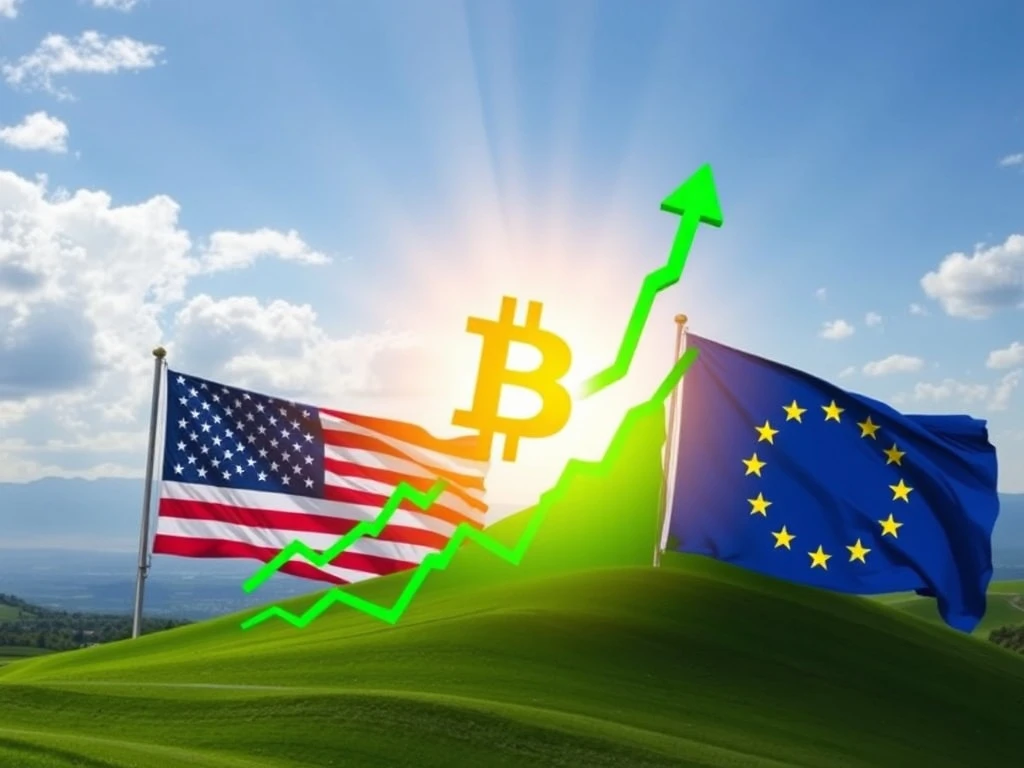Bitcoin Unleashes Remarkable 12% Surge After Groundbreaking US-EU $1.35 Trillion Trade Deal

The cryptocurrency world recently witnessed a seismic shift as Bitcoin (BTC) experienced an astounding 12% surge. This dramatic price movement wasn’t a random fluctuation but a direct response to a monumental global event: the U.S.-European Union’s $1.35 trillion trade agreement. This **Bitcoin surge** has ignited optimism across financial markets, signaling a potential easing of long-standing **market uncertainties**.
Bitcoin’s Explosive Response: A 12% Surge
In the days following the announcement, Bitcoin’s price skyrocketed by nearly 12%, reaching an impressive range of $119,000 to $120,000. This **Bitcoin surge** wasn’t isolated; it reflected a broader wave of positive sentiment that swept through global markets. Equities gained traction, and major cryptocurrencies followed suit, all buoyed by the prospect of reduced economic instability. Thomas Lee, Head of Research at Fundstrat Global Advisors, underscored the significance, stating the deal “removes a critical tail risk” for markets, a development he described as “good for equities and Bitcoin.” His analysis highlights the increasing interconnectedness between macroeconomic developments and the performance of risk assets like Bitcoin.
The Game-Changing US-EU Trade Deal: What You Need to Know
On October 13, 2023, the U.S. and European Union finalized a historic **US-EU trade deal** valued at an astonishing $1.35 trillion. Negotiated by former U.S. President Donald Trump and EU Commission President Ursula von der Leyen, this agreement is designed to alleviate the persistent macroeconomic uncertainties that have previously weighed on global markets. Key components of the deal include:
- **$600 billion** in EU investments earmarked for the U.S.
- **$750 billion** in U.S. purchases of European resources.
This landmark agreement is poised to stabilize cross-border trade tensions and significantly reduce systemic risks for financial markets, fostering a more predictable economic environment.
Navigating Market Uncertainties: Why This Deal Matters
The core impact of this agreement lies in its ability to mitigate **market uncertainties**. For years, geopolitical tensions and trade disputes have cast a long shadow over global finance, leading to volatility and cautious investor behavior. This **US-EU trade deal** provides a much-needed antidote, offering clarity and predictability. This mirrors the positive market reaction seen during the U.S.-China Phase One deal in 2020, which similarly boosted equities and cryptocurrencies by resolving long-standing trade issues. Fund managers and analysts are increasingly viewing Bitcoin and large-cap altcoins, such as BNB (which reportedly hit all-time highs post-announcement), as strategic hedges against these macroeconomic shifts, highlighting their evolving role in diversified portfolios.
The Broader Picture: Economic Stability and Crypto’s Role
The pursuit of **economic stability** is a driving force behind such monumental trade agreements. When major economies like the U.S. and E.U. align on trade policy, it sends a powerful signal of confidence to investors worldwide. This stability often encourages increased allocation to risk assets, and cryptocurrencies are increasingly fitting this description. Bitcoin, in particular, has cemented its position as both a speculative investment vehicle and a potential hedge against inflation, making it an attractive option in a more stable, yet still dynamic, global landscape. The alignment of this **US-EU trade deal** with broader macroeconomic stability goals further reinforces Bitcoin’s legitimacy and role in diversified investment strategies, reflecting a growing trend of institutional adoption.
Looking Ahead: Long-Term Implications for the Cryptocurrency Market
While the immediate **Bitcoin surge** is evident, the long-term implications for the **cryptocurrency market** remain intertwined with broader economic trends. Sustained price performance will depend heavily on the successful implementation of the agreement’s terms and the evolving global economic conditions. However, the reduction of trade-related uncertainties could foster an environment where digital assets are increasingly seen as integral components of investment portfolios. As cross-border cooperation continues to shape global markets, the dynamic interplay between trade policy and digital assets is expected to remain a critical area of focus for investors, policymakers, and the entire **cryptocurrency market** ecosystem.
The U.S.-EU $1.35 trillion trade deal marks a pivotal moment for global markets and, notably, for Bitcoin. By easing significant macroeconomic uncertainties, this agreement has not only propelled Bitcoin’s price but also reinforced its growing role as a vital asset in diversified portfolios. As the world navigates complex economic landscapes, the nexus between international trade policy and the performance of digital assets like Bitcoin will continue to be a compelling narrative for investors worldwide.
Frequently Asked Questions (FAQs)
1. What triggered the recent 12% Bitcoin surge?
The recent 12% Bitcoin surge was primarily triggered by the announcement of a $1.35 trillion trade agreement between the U.S. and the European Union. This deal significantly eased macroeconomic uncertainties, leading to increased investor confidence across global markets, including cryptocurrencies.
2. What are the key details of the U.S.-EU $1.35 trillion trade deal?
The U.S.-EU trade deal, finalized on October 13, 2023, involves $600 billion in EU investments in the U.S. and $750 billion in U.S. purchases of European resources. Its main objective is to mitigate cross-border trade tensions and reduce systemic risks for financial markets.
3. How does this trade agreement reduce market uncertainties?
By establishing clear terms for trade and investment between two major economic blocs, the agreement creates a more predictable and stable economic environment. This predictability reduces the “tail risks” associated with trade disputes and geopolitical tensions, encouraging investors to re-engage with risk assets like Bitcoin.
4. Does this event signify Bitcoin’s role as an economic stability indicator?
While Bitcoin is still a volatile asset, its positive response to the U.S.-EU trade deal highlights its increasing correlation with macroeconomic stability. Analysts view such agreements as removing critical risks, which is seen as positive for both equities and Bitcoin, suggesting its growing role in diversified portfolios as both a speculative investment and a potential hedge against broader economic shifts.
5. What are the potential long-term implications of this deal for the cryptocurrency market?
In the long term, the reduction of trade-related uncertainties could encourage greater allocation to risk assets, potentially benefiting the cryptocurrency market. However, sustained positive performance will depend on the successful implementation of the deal’s terms and the evolving global economic conditions. The deal reinforces the interplay between trade policy and the digital asset landscape.










